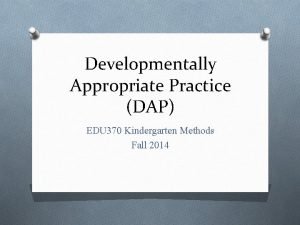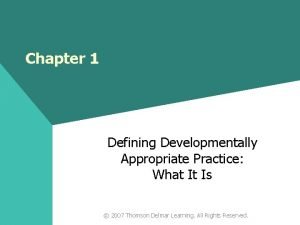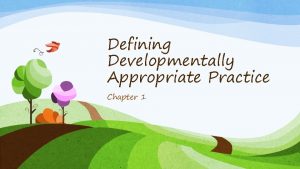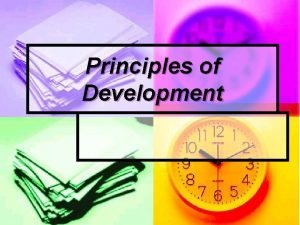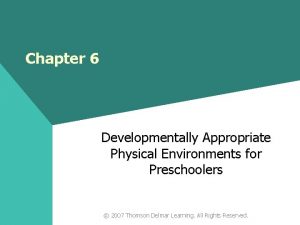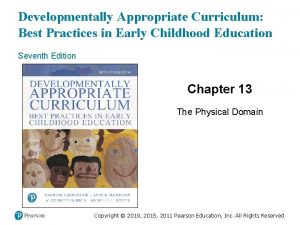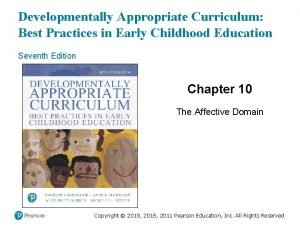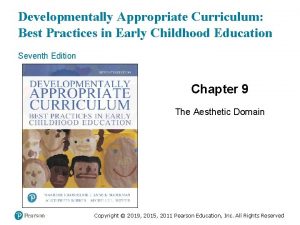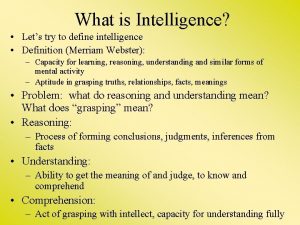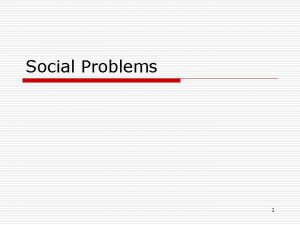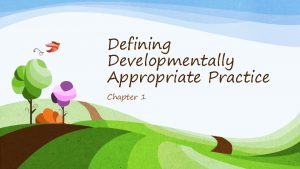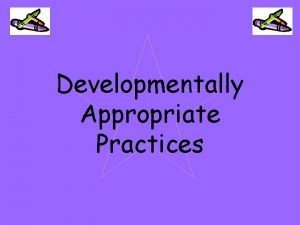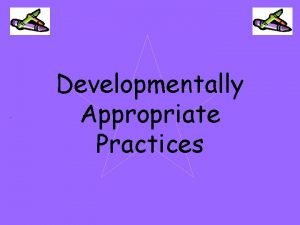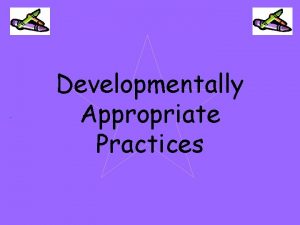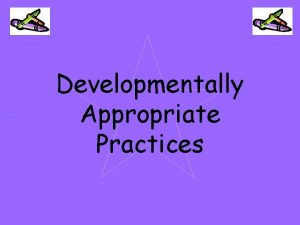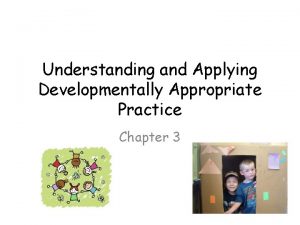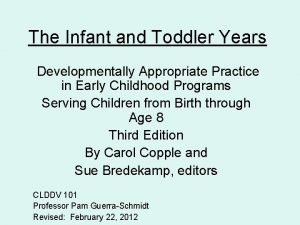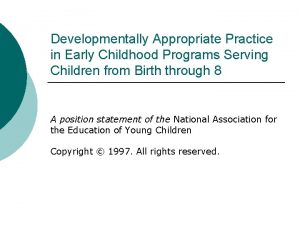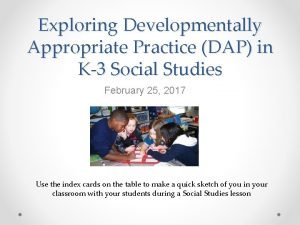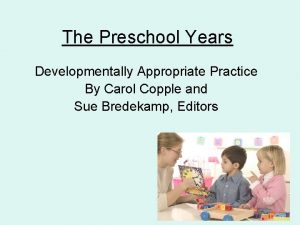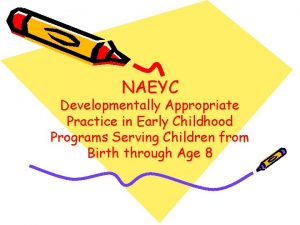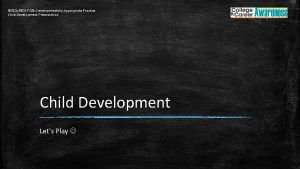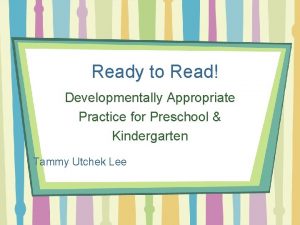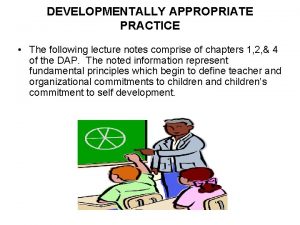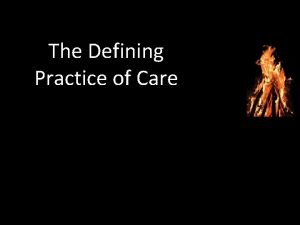Defining Developmentally Appropriate Practice Chapter 1 Developmentally Appropriate




















- Slides: 20

Defining Developmentally Appropriate Practice Chapter 1

Developmentally Appropriate Practice • The first definitive position on developmentally appropriate practice was adopted by the National Association for the Education of Young Children. • DAP is focused on how best to serve the needs of developing children. • Dap is based on the accumulation of data and facts of what children are like. • Dap is not a curriculum it is a framework, a philosophy, or an approach to working with young children. • Decisions are made on the basis of child development knowledge and also on the basis of family, community, and cultural values and priorities.

Guidelines in five interrelated dimensions of early childhood program practice. 1. Creating a caring community of learner, within the context of relationships in the classroom. 2. Teaching to enhance development and learning, with a consideration of teacher roles and strategies to support children’s learning process. 3. Constructing appropriate curriculum, with attention to both content and strategies. 4. Assessing children’s learning and development. 5. Establishing reciprocal relationships with families. Creating a caring Community of learnings Establishing Reciprocal Relationships With families Dimensions of early childhood practice Assessing Children’s learning And development Constructing Appropriate curriculum Teaching to Enhance Development And Learning

Essential Components of DAP As the NAEYC position statement reminds, three important kinds of information and knowledge form the basis of professional decision making. 1. What is known about child development and learning Knowledge of age-related human characteristics that permits general predictions about what experiences are likely to best promote children’s learning and development. 2. What is known about each child as an individual By observing, interacting, considering children’s work, and talking with families, teachers learn the individual uniqueness of each child. 3. What is known about the social and cultural context DAP emphasizes recognizing the influence of culture and home experiences on each child’s development.

Basic Principles of Development 1. All the domains of development and learning- physical, social, emotional, and cognitive- are important, and they are closely interrelated. 2. Many aspects of children’s learning and development follow well-documented sequences, with later abilities, skills, and knowledge building on those already acquired. 3. Development and learning proceed at varying rates from child to child, as well as at uneven rates across different areas of a child’s individual functioning. 4. Development and learning results from a dynamic and continuous interaction of biological maturation and experience. 5. Early experiences have profound effects, both cumulative and delayed, on a child’s development and learning; and optimal periods exist for certain types of development and learning to occur. 6. Development proceeds toward greater complexity, self-regulation, and symbolic or representational capacities. 7. Children develop best when they have secure, consistent relationships with responsive adults and opportunities for positive relationships with peers. 8. Development and learning occur in and are influenced by multiple social and cultural contexts.

Basic Principles of Development 12. Children’s experiences shape their 9. Always mentally active in seeking to motivation and approaches to learning, understand the world around them, such as persistence, initiative, and children learn in a variety of ways; a flexibility; in turn, these dispositions and wide range of teaching strategies and behaviors affect their learning and interactions are effective in supporting all development. these kinds of learning. 10. Play is an important vehicle for developing self-regulation as well as promoting language, cognition, and social competence. 11. Development and learning advance when children are challenged to achieve at a level just beyond their current mastery, and also when they have many opportunities to practice newly acquired skills.

Results of DAP q Self-Esteem q Self-esteem grows as children are able to master new experiences and challenges in their lives. q Self-Control q As children mature cognitively, they are increasingly able to govern their behavior according to the guidance they have received from adults. q Stress is a common risk noted in children when excessive and inappropriate demands are made on them through formal instruction. With DAP stress levels decrees frequently. q Later Academic Patterns q DAP academic is beneficial by delaying exposure to inappropriate instruction methods.

Misunderstandings About DAP 10 Common misunderstanding regarding Developmentally Appropriate Practace.

Misunderstanding 1 There Is Only One Right Way to Carry Out Developmentally Appropriate Practice This untrue characterization makes it seem as though developmentally appropriate practices add up to a single curriculum. Teachers who follow developmentally appropriate practices are not looking only for on right answer, but for the best answer for these particular children at this particular time.

Misunderstanding 2 Developmentally Appropriate Classrooms are Unstructured Structure refers to the teachers’ formulations of instructional plans and their careful orchestration of space, time, materials, and interaction in the physical, social/emotional, and cognitive/language environments to achieve their instructional goals.

Misunderstanding 3 Teachers Teach Minimally or Not at All in Developmentally Appropriate Classroom The misunderstanding relies on the limited view that teachers teach only by directing and controlling all learning in a classroom. Teachers in developmentally appropriate classrooms teach by supporting children’s active learning with a multitude of direct and indirect stratgies.

Misunderstanding 4 Developmentally Appropriate Programs Don’t Include Academics, Generally Interpreted to Be the Formal Skills of Learning Reading, Writing, and Arithmetic In a developmentally appropriate classroom, academic content is presented by integration with all other classroom experiences. A developmental approach to education does not deny the importance of such knowledge.

Misunderstanding 5 Developmentally Appropriate Programs Are Effective Only for Particular Populations, “Usually Assumed to Be Typically Developing, White, Middle-Class Children” This implies that children of diverse racial, cultural, or socioeconomic backgrounds, or children with special needs, will not be well served in such programs. Teachers using DAP must work to make their classrooms individually appropriate for every child and supported by every parents.

Misunderstanding 6 In Developmentally Appropriate Classrooms, There Is No Way to Tell if Children Are Learning This misunderstanding here is that methods other than the traditional, easily applied techniques of testing children’s retention of material are used. The essence of teaching in a developmentally appropriate classroom lies in continual observation of children’s play, language, interaction, and increasing abilities to use literacy skills and other media to communicate their learning. As teachers record specific observations, they identify patterns of growth and change in each child.

Misunderstanding 7 Developmentally Appropriate Practice Can Be Achieved Simply by Acquiring Certain Kinds of Toys and Materials Teachers in developmentally appropriate classrooms understand that children’s actions and interactions with materials help them create their own sensorimotor understands, preoperational learning, and concrete concepts.

Misunderstanding 8 Developmentally Appropriate Practice Uses No Goals or Objectives The misunderstand results from the phrase “child centered” and the belief that children alone decide what they will learn and how they will the learn. “All effective educational programs have clearly stated objectives toward which the teacher plans and work with children to achieve”(Bredekamp & Rosegrant, 1992. p. 5. ) Children’s needs, questions, and interests play a major role in influencing teacher planning in a child-centered curriculum; however teachers also know how, why, and when to extend learning possibilities in play and projects.

Misunderstanding 9 In Developmentally Appropriate Practice, the Curriculum Is Child Development This misunderstanding loses sight of the fact that other knowledge must work together with child development to ensure that all children reach their individual potentials. Development is only one of three dimensions that influence classroom practices. The other two dimensions include the cultural dimension and the knowledge dimension.

Misunderstanding 10 Developmental Appropriateness Is Just One in a Sequence of Changing Trends in Education Of course there have been changes in what educators have been asked to teach. In developmental appropriateness is conceived as an evolving of professional thinking that will continue. The roots of developmental practice lie in the work of the “great thinkers of human development that have informed education practice over the past 100 years- Montessori, Piaget, Freud, Steiner, Erikson, Dewey, Elkind, Gardner- and to the newest findings in how the brain develops over the course of childhood” (Armstrong, 2006).

Principles of Appropriate and Inappropriate Practice There is general agreement on these practices as: Developmentally appropriate • Curriculum and experiences that actively engage children Developmentally inappropriate • Highly linear instruction, especially following an inflexible timeline • Rich, teacher-supported play • Heavy reliance on whole-group instruction • Integrated curriculum • • Scope for children’s initiative and choice Fragmented lessons without connections meaningful to children • • Intentional decisions in the organization and timing of learning experiences Rigid adherence to package curriculum, without regard for children’s responses • Narrow focus, such as only on literacy and math instruction • Highly prescriptive requirements, and rigid timelines for achieving them • Adapting curriculum and teaching strategies to help individual children make optimal progress

Summary • DAP specifies the provision of active learning experiences, intentionally supported by knowledgeable and responsive teachers using a wide repertoire of teaching strategies. • The most important component may be the respect for children and their characteristics. • A number of misunderstandings have arisen among practitioners about the implications of developmentally appropriate practices. • Inappropriate practices for young children create negative results.
 Dap kindergarten
Dap kindergarten Developmentally appropriate practices definition
Developmentally appropriate practices definition Define developmentally appropriate practice
Define developmentally appropriate practice Development occurs in a relatively orderly sequence
Development occurs in a relatively orderly sequence Developmentally appropriate environment
Developmentally appropriate environment Developmentally appropriate curriculum 7th edition
Developmentally appropriate curriculum 7th edition An appropriate developmental curriculum
An appropriate developmental curriculum Developmentally appropriate curriculum 7th edition
Developmentally appropriate curriculum 7th edition Defining and non defining sentences
Defining and non defining sentences Relative clauses defining and non defining
Relative clauses defining and non defining Oraciones defining y non defining
Oraciones defining y non defining Defining relative clause meaning in telugu
Defining relative clause meaning in telugu Defining non defining farkı
Defining non defining farkı Nonessential relative clause
Nonessential relative clause Defining policy practice in social work
Defining policy practice in social work Practice assessor feedback examples
Practice assessor feedback examples Definition of smartness
Definition of smartness The defining moment in greek history is the wars
The defining moment in greek history is the wars 4 key characteristics of chordates
4 key characteristics of chordates Define social problems
Define social problems Romeo and juliet act 4 summary
Romeo and juliet act 4 summary
